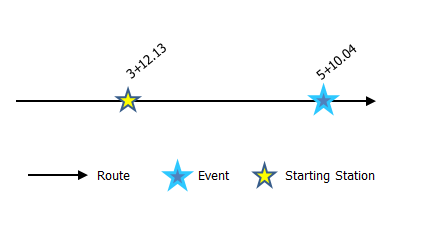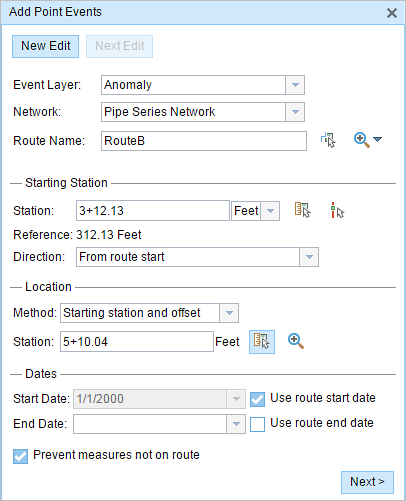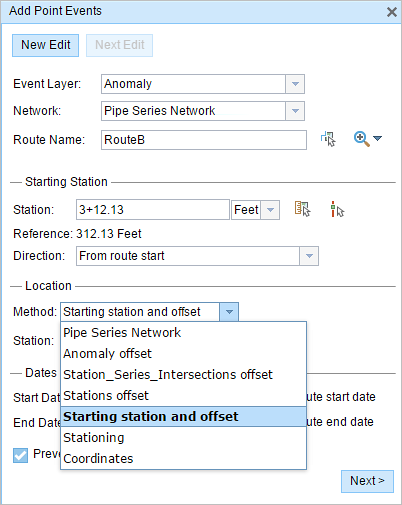Disponible con licencia de Location Referencing.
Use stationing to locate measures
Stationing is the fundamental system of measurement used for pipeline layout and construction. Stations are reference points that are placed along the horizontal measurement of a route centerline or a baseline at some regular interval. Generally, the distance between two adjoining stations along a route is 100 feet. The first station located at the beginning of the baseline is 0+00, and the next station located 100 feet from it is 1+00. Therefore, a station number of 10+34.05 denotes 1,034.05 feet (10*100 + 34.05) from the starting station.

The station numbers increase from west to east or south to north based on the cardinal direction of the overall pipeline. For pipeline projects, a starting reference station is first established, and all distances along the route centerline are measured from that point location. You can add event data to routes by entering station numbers in the Point Events tool interface. The station data is translated to routes and measures for storage.
You can use the stationing data as an input for adding point events by using these three scenarios:
- Create a starting or base station on the route and define the station values as offsets from that station.
- Identify a starting or base station on the route and define the station values as offsets from that location.
- Use the existing stations on the route to calculate or define measures in the form of station values.
Locate measures by creating a starting or base station on the route
You can use this method when no stations are present on the route. You'll create a starting or base station on the route and define stationing values for measures. The measures will be located at an offset from the starting station. As shown in the example below, a starting station (yellow star) is temporarily located and a station value is provided. The new point event's location is then identified using an offset distance (in station values) from that starting station. When new point events are created using this method, the stationing data is translated to routes and measures for storage.

- Open ArcGIS Event Editor and, if prompted, sign in to your ArcGIS organization.
- Click the Edit tab.
- In the Edit Events group, click the Point Events button
 .
.The Add Point Events widget appears.

The widget is unavailable when there are no editable point event layers in the map.
- Click the Event Layer drop-down arrow and choose an event layer to edit.
- Click the Network drop-down arrow and choose the network that will serve as a source for providing the measure for the new event.
- The widget accepts an LRS Network as a source to identify the location for adding the new point event. However, when the new point event data is being stored in the database, the app performs an internal translation of measures to always store the measure value in the linear referencing method (LRM) of the LRS Network with which the event is registered.
- The Network value can be a published LRS Network layer.
- In the Location section, click the Method drop-down arrow and click Starting station and offset.

The Starting Station section appears.
- In the Starting Station section, click the drop-down arrow and choose the units for station values.
- In the Starting Station section, for Station, click the Select a Location on the Map tool
 and select the location of the starting station on a route in the map.
and select the location of the starting station on a route in the map.- A yellow star indicates the location of the starting station on a route in the map.
- The linear referencing method (LRM) measure equivalent to the location is displayed in Reference. For example, if the LRM is milepoint, the number of miles at that location is displayed.
- Type the station number in the Stationing text box.
- The Route Name text box is populated in the From section.
- In the Starting Station section, click the Direction drop-down arrow and choose the direction.
This selection indicates the direction the station values increase along the route compared to the direction of calibration of the route.
- In the Location section, provide the station number using one of the following options to allocate the measure for the new point event:
- Type the station number in the Station text box.
- Click the Select a Location on the Map tool
 and click a location on the selected route. The station number is populated in the Station text box.
and click a location on the selected route. The station number is populated in the Station text box.
The measure location will be placed at an offset from the starting station.
A red x appears at the selected location on the map.
- Choose the date that will define the start date of the events by doing one of the following:
- Type the start date in the Start Date text box.
- Click the Start Date drop-down arrow and choose the start date.
- Check the Use route start date check box.
The start date defaults to today's date, but you can choose a different date using the date picker.
Nota:
If you configured your Event Editor instance to not allow dates before the start date of the route, and you provide a date before the start date of the selected route in Start Date, a warning message appears alerting you to choose a date on or after the start date of the selected route.
- Choose the date that will define the end date of the events by doing one of the following:
- Type the end date in the End Date text box.
- Click the End Date drop-down arrow and choose the end date.
- Check the Use route end date check box.
The end date is optional, and if it is not provided, the event remains valid now and into the future.
- The Prevent measures not on route check box is checked by default.
Prevent measures not on route—This data validation option ensures that the input measure values for the start and end measures fall in the minimum and maximum range of measure values on the selected route.
- Click Next to view the Attribute Value table.
This table contains all the attributes of the event layer.
- Provide attribute information for the new event in the table.
Sugerencia:
You can click the Copy Attribute Values button
 and click an existing point event belonging to the same event layer on the map to copy event attributes from that point.
and click an existing point event belonging to the same event layer on the map to copy event attributes from that point. - Check the Show network name check box to show the LRS Network with which the selected event layer is associated.
- Click Save.
A confirmation message appears at the lower right once the newly added point event is saved. The new point is created and appears on the map.
After a point event has been successfully created, you have the following two options to continue characterizing the route:
- Click New Edit to clear all the input entries in the widget and restore the default values from the geodatabase to the table.
- Click Next Edit to retain all the existing entries in the widget and the attribute set for convenience and for quick editing of similar characteristics.